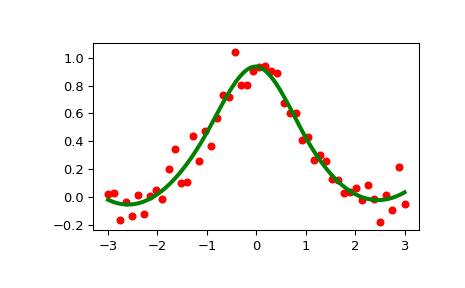LSQUnivariateSpline#
- class scipy.interpolate.LSQUnivariateSpline(x, y, t, w=None, bbox=[None, None], k=3, ext=0, check_finite=False)[source]#
1-D spline with explicit internal knots.
Legacy
This class is considered legacy and will no longer receive updates. While we currently have no plans to remove it, we recommend that new code uses more modern alternatives instead. Specifically, we recommend using
make_lsq_splineinstead.Fits a spline y = spl(x) of degree k to the provided x, y data. t specifies the internal knots of the spline
- Parameters:
- x(N,) array_like
Input dimension of data points – must be increasing
- y(N,) array_like
Input dimension of data points
- t(M,) array_like
interior knots of the spline. Must be in ascending order and:
bbox[0] < t[0] < ... < t[-1] < bbox[-1]
- w(N,) array_like, optional
weights for spline fitting. Must be positive. If None (default), weights are all 1.
- bbox(2,) array_like, optional
2-sequence specifying the boundary of the approximation interval. If None (default),
bbox = [x[0], x[-1]].- kint, optional
Degree of the smoothing spline. Must be 1 <= k <= 5. Default is k = 3, a cubic spline.
- extint or str, optional
Controls the extrapolation mode for elements not in the interval defined by the knot sequence.
if ext=0 or ‘extrapolate’, return the extrapolated value.
if ext=1 or ‘zeros’, return 0
if ext=2 or ‘raise’, raise a ValueError
if ext=3 of ‘const’, return the boundary value.
The default value is 0.
- check_finitebool, optional
Whether to check that the input arrays contain only finite numbers. Disabling may give a performance gain, but may result in problems (crashes, non-termination or non-sensical results) if the inputs do contain infinities or NaNs. Default is False.
Methods
__call__(x[, nu, ext])Evaluate spline (or its nu-th derivative) at positions x.
antiderivative([n])Construct a new spline representing the antiderivative of this spline.
derivative([n])Construct a new spline representing the derivative of this spline.
derivatives(x)Return all derivatives of the spline at the point x.
Return spline coefficients.
Return positions of interior knots of the spline.
Return weighted sum of squared residuals of the spline approximation.
integral(a, b)Return definite integral of the spline between two given points.
roots()Return the zeros of the spline.
Continue spline computation with the given smoothing factor s and with the knots found at the last call.
validate_input
- Raises:
- ValueError
If the interior knots do not satisfy the Schoenberg-Whitney conditions
See also
UnivariateSplinea smooth univariate spline to fit a given set of data points.
InterpolatedUnivariateSplinea interpolating univariate spline for a given set of data points.
splrepa function to find the B-spline representation of a 1-D curve
spleva function to evaluate a B-spline or its derivatives
sproota function to find the roots of a cubic B-spline
splinta function to evaluate the definite integral of a B-spline between two given points
spaldea function to evaluate all derivatives of a B-spline
Notes
The number of data points must be larger than the spline degree k.
Knots t must satisfy the Schoenberg-Whitney conditions, i.e., there must be a subset of data points
x[j]such thatt[j] < x[j] < t[j+k+1], forj=0, 1,...,n-k-2.Array API Standard Support
LSQUnivariateSplineis not in-scope for support of Python Array API Standard compatible backends other than NumPy.See Support for the array API standard for more information.
Examples
>>> import numpy as np >>> from scipy.interpolate import LSQUnivariateSpline, UnivariateSpline >>> import matplotlib.pyplot as plt >>> rng = np.random.default_rng() >>> x = np.linspace(-3, 3, 50) >>> y = np.exp(-x**2) + 0.1 * rng.standard_normal(50)
Fit a smoothing spline with a pre-defined internal knots:
>>> t = [-1, 0, 1] >>> spl = LSQUnivariateSpline(x, y, t)
>>> xs = np.linspace(-3, 3, 1000) >>> plt.plot(x, y, 'ro', ms=5) >>> plt.plot(xs, spl(xs), 'g-', lw=3) >>> plt.show()

Check the knot vector:
>>> spl.get_knots() array([-3., -1., 0., 1., 3.])
Constructing lsq spline using the knots from another spline:
>>> x = np.arange(10) >>> s = UnivariateSpline(x, x, s=0) >>> s.get_knots() array([ 0., 2., 3., 4., 5., 6., 7., 9.]) >>> knt = s.get_knots() >>> s1 = LSQUnivariateSpline(x, x, knt[1:-1]) # Chop 1st and last knot >>> s1.get_knots() array([ 0., 2., 3., 4., 5., 6., 7., 9.])